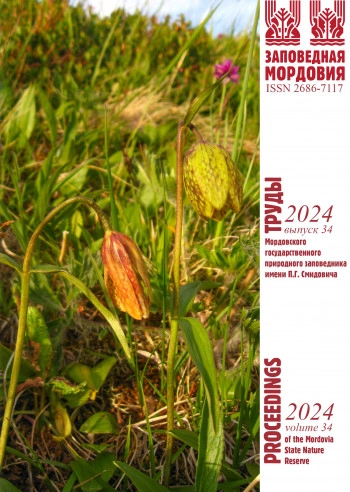В работе мы обобщили современные сведения о видовом разнообразии паразитических гельминтов рукокрылых, населяющих Среднее Поволжье. В той или иной степени, гельминтологическому обследованию были подвергнуты все 16 видов рукокрылых, обитающих на исследуемой территории. По нашим и литературным данным, у рукокрылых зарегистрировано 38 видов паразитов: 3 ленточных червя, 24 сосальщика, 98 нематод и один скребень. Ядро гельминтофауны летучих мышей составляют хозяиноспецифичные виды, паразитирующие только на рукокрылых. Трематода Prosthodendrium cryptholecithum и нематода Physaloptera clausa, juv. указаны для рукокрылых России впервые. А трематоды Gyrabascus amphoraeformis и G. oppositus обнаружены впервые для рукокрылых Среднего Поволжья. Для трех видов гельминтов летучих мышей выявлены новые хозяева. Анализ паразитов рукокрылых показал, что наиболее разнообразна гельминтофауна Nyctalus noctule (19 видов гельминтов), Myotis brandtii, Pipistrellus nathusii (по 15 видов соответственно) и Vespertilio murinus (14 видов гельминтов). Самый широкий круг окончательных хозяев среди рукокрылых Среднего Поволжья характерен для Plagiorchis koreanus, P. chilostomum и Pterothominx neopulchra (по 9 видов у каждого). Большинство гельминтов летучих мышей обладают высокой степенью хозяиноспецифичности. Из 38 видов паразитов, обнаруженных у представителей отряда рукокрылых, 34 вида гельминтов паразитируют только у летучих мышей. Лишь четыре вида гельминтов (Plagiorchis elegans, Ph. clausa, juv., Physocephalus sexalatus, juv., Moniliformis moniliformis, lrv.) проявляют широкую степень специфичности к хозяину, паразитируя на других позвоночных.
In this study, we summarize up-to-date information on the species diversity of parasitic helminths in bats inhabiting the Middle Volga region. To one degree or another, all 16 species of bats living in the studied area were subjected to helminthological survey. According to our and literature data, 38 species of parasites were recorded in chiropterans: three tapeworms, 24 flukes, 98 nematodes, and one acanthocephalan. The core of this bat helminth fauna is formed by host-specific species that parasitize only chiropterans. The trematode Prosthodendrium cryptholecithum and nematode Physaloptera clausa, juv. are recorded for the first time in the bats in Russia. The trematodes Gyrabascus amphoraeformis and G. oppositus were recorded for the first time in the bats inhabiting the Middle Volga region. For three species of bat helminths, new hosts were revealed. The analysis of bat parasites showed that the helminth fauna of the Nyctalus noctula (19 helminth species), Myotis brandtii, Pipistrellus nathusii (15 species each) and Vespertilio murinus (14) is the most diverse. The widest range of final hosts among bats inhabiting the Middle Volga region is a characteristic for Plagiorchis koreanus, P. chilostomum and Pterothominx neopulchra (9 species each). Majority of bat helminths possesses a high degree of host specificity. Out of 38 parasite species found in representatives of the order Chiroptera, 34 species of helminths parasitize exclusively on bats. Only four species of helminths (Plagiorchis elegans, Ph. clausa, juv., Physocephalus sexalatus, juv., Moniliformis moniliformis, lrv.) demonstrate a broad degree of host specificity, parasitizing on other vertebrates.











